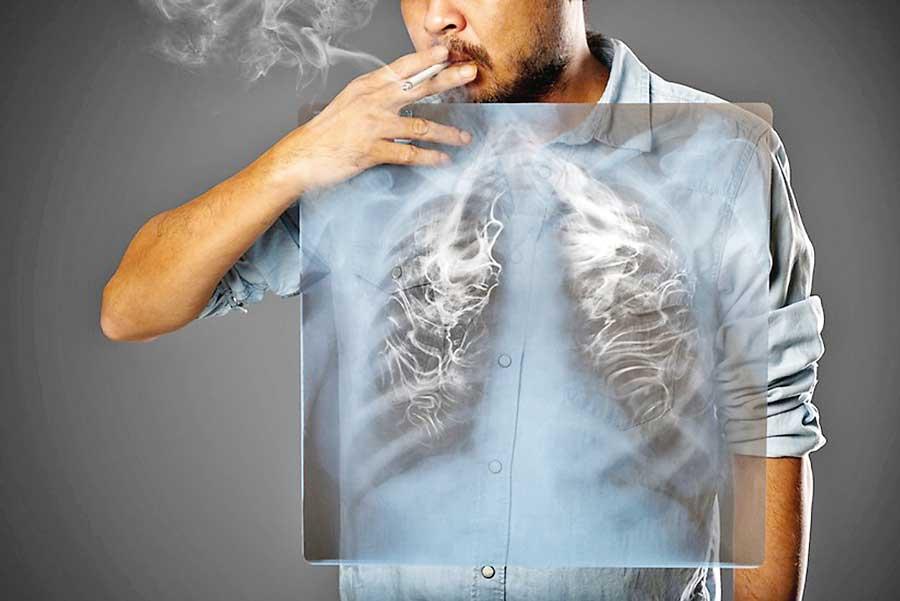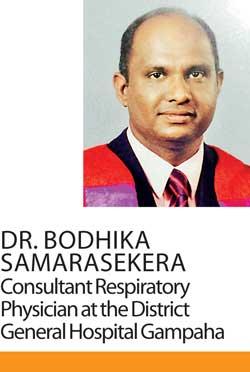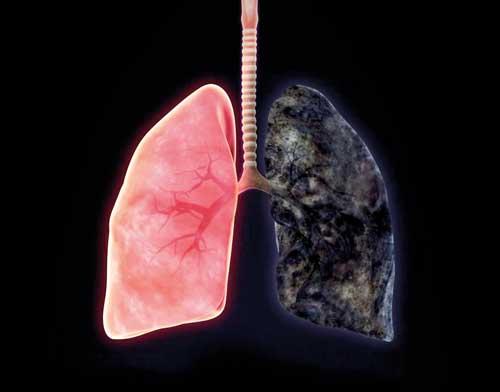19 Jul 2019 - {{hitsCtrl.values.hits}}

 Chronic Obstructive Pulmonary disease (COPD) is a serious illness of the lungs. While the name itself may not be very familiar, the condition is extremely common and lethal; currently holding the position for the world’s 4th leading cause of death. Smoking and inhaling polluted air for long periods of time have been found to be major contributors towards COPD. While the presentation of COPD is somewhat similar to asthma, it is usually more severe and more difficult to treat. Today in Health capsule, Dr.Bodhika Samarasekera, Consultant Respiratory Physician at the District General Hospital Gampaha, joins to in educate readers on COPD.
Chronic Obstructive Pulmonary disease (COPD) is a serious illness of the lungs. While the name itself may not be very familiar, the condition is extremely common and lethal; currently holding the position for the world’s 4th leading cause of death. Smoking and inhaling polluted air for long periods of time have been found to be major contributors towards COPD. While the presentation of COPD is somewhat similar to asthma, it is usually more severe and more difficult to treat. Today in Health capsule, Dr.Bodhika Samarasekera, Consultant Respiratory Physician at the District General Hospital Gampaha, joins to in educate readers on COPD.
Permanent damage
COPD is an inflammatory lung disease that is characterised by persistent respiratory symptoms such as wheezing and cough, with difficulty in breathing, which occurs due to the limitation of airflow to the lungs. The symptoms occur as a result of the permanent damage to the airway and lung tissue. Therefore, the limitation caused to the airway cannot be reversed, unlike in asthma, which is a reversible condition caused by the inflammation of the airways. COPD is usually caused by the significant exposure of one’s respiratory system to noxious particles which are usually emitted from tobacco smoking and air pollution.
COPD is a common, preventable and treatable lung disease. However, COPD is currently the 4th leading cause of death in the world and projected to be the 3rd leading cause of death by year 2020.
Signs and symptoms
The symptoms of COPD usually do not appear until significant lung damage has occurred. It is a disease that sneaks up on people who are exposed to risk factors, taking years to show signs and symptoms. The patients usually complain of shortness of breath, especially during physical activities. In addition, they may get wheezing and chronic cough that may produce mucus (Phlegm). They may also complain of tightness of the chest. All these symptoms may also occur in asthma exacerbations. However, the symptoms of COPD are usually persistent than in asthma.
Causes
COPD is usually caused by the long-term exposure to lung irritants which damage the lung and the air ways. The most common lung irritant that causes COPD throughout the world is identified as the cigarette smoke. The chemicals contained in the inhaled smoke damage the airways and this damage can be permanent with time. In addition, Cigar, pipe and other kinds of tobacco smoking can also lead to COPD.
Exposure to second hand smoke- coming from other people who smoke- over a period of time is also a known cause for COPD. Therefore, there is a possibility of close associates of smokers, who do not smoke, getting COPD after being exposed to the residual smoke. Furthermore, the indoor air pollution from burning mosquito coils, incentive sticks and using Bio mass fuel such as firewood for cooking can also damage the lungs and airways to ultimately cause COPD. Outdoor pollution due to fumes, chemicals and dust can also damage the lungs and airways.
Diagnosis
It is very important to differentiate COPD from Asthma, since the initial presentation can be similar in both conditions. A history of smoking would point towards a diagnosis of COPD rather than asthma. In addition, the patient would be asked to undergo a simple non invasive test called spirometry (Lung function Test). This test measures how much air you can breathe in and out, and how fast you can exhale the air. There are also advanced lung function tests that measure how well your lungs deliver oxygen to your blood.
In addition, your caring team may ask you to undergo a chest x-ray. Sometimes you may need to undergo CT Chest and arterial blood gas (a blood sample from a artery to asses blood oxygen and carbon dioxide levels) as well.
Management 
Even though there is no permanent cure for COPD, there are many measures which can be taken to slow the progression of the disease. These include medication such as inhalers (bronchodilators and sometimes steroids inhalers), oxygen therapy in advanced disease and pulmonary rehabilitation. All patients with COPD should take Flu vaccine yearly and pneumococcal vaccine every 5 years in order to minimise the risk of infections that may cause further lung damage.
Pulmonary rehabilitation is a programme that helps people with long-standing breathing problems and especially improves the well-being of COPD patients. Pulmonary rehabilitation consists of a personalised exercise programme, disease management training, Nutrition programme and psychological counselling.
Smoking cessation and avoidance of other lung irritants play major roles in preventing further lung damage. Hence all COPD patients are encouraged to completely quit smoking immediately. In addition, second hand smoking and exposure of other lung irritants should be avoided.
The health principle ‘prevention is better than cure’ applies in case of COPD as well, especially since no permanent cure has yet been found for it. The risk of getting COPD can be minimised through modifying your lifestyle to curtail exposure to polluted air. In this aspect, you can reduce the risk of COPD to your loved ones as well as you by quitting smoking.
Seeking medical help if you are having prolonged respiratory symptoms like difficulty in breathing, chronic cough and wheezing would aid in diagnosing COPD. Following your doctor’s advice, while taking the medication as prescribed is crucial in controlling the disease symptoms.
22 Dec 2024 1 hours ago
22 Dec 2024 2 hours ago
22 Dec 2024 4 hours ago
22 Dec 2024 4 hours ago
21 Dec 2024 21 Dec 2024